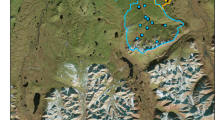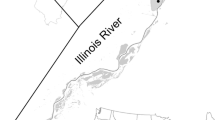Abstract
Perspectives addressing either “local” or “routing” control over ecological form and function alternatively emphasize ambient conditions or recognize that form and processes at one location may be heavily influenced by other points in space. In their natural state, floodplains of montane gravel-bed rivers are organized laterally into parafluvial zones, where scour occurs annually, and orthofluvial environments, within which active (that is, early successional) and passive (that is, late successional) zones differ in regard to flooding influences. Vertically, these rivers interact with extensive alluvial aquifers throughout the length of their floodplains. We addressed how local and routing controls organize riverscape structure and function by investigating seasonal dynamics of interstitial dissolved oxygen (DO) vertically within the alluvial aquifer, longitudinally along flowpaths, and laterally across active and passive orthofluvial (PO) zones in the Nyack floodplain, Middle Fork Flathead River, MT. Groundwater DO was positively correlated to pH and negatively correlated electrical conductivity (EC) across all seasons. In some wells (7 of 19), DO was significantly lower and EC greater at shallow depths, and the magnitudes of vertical zonation were related to dissolved organic carbon concentrations. Longitudinal declines in DO were always and exclusively observed along flowpaths of the PO zone. At the same time, persistent hypoxic patches within the active orthofluvial environment suggest metabolic hotspots that contribute to local control of physicochemistry. In ecosystems heavily influenced by material transport, local and routing controls may be manifested simultaneously as distinct patterns of organization, which are expressed at different spatial and temporal scales.





Similar content being viewed by others
References
Andrews JA, Schlesinger WH. 2001. Soil CO2 dynamics, acidification, and chemical weathering in a temperate forest with experimental CO2 enrichment. Glob Biogeochem Cycles 45:149–62.
Baker MA, Valett HM, Dahm CN. 2000. Organic carbon supply and metabolism in a shallow groundwater ecosystem. Ecology 81:3133–48.
Barbaro SE, Albrechtsen HJ, Jensen BK, Mayfield CI, Barker JF. 1994. Relationships between aquifer properties and microbial populations in the borden aquifer. Geomicrobiol J 12:203–19.
Battin TJ, Kaplan LA, Newbold JD, Hendricks SP. 2003. A mixing model analysis of stream solute dynamics and the contribution of a hyporheic zone to ecosystem function. Freshw Biol 48:995–1014.
Brugger A, Reitner B, Kolar I, Queric N, Herndl GJ. 2001. Seasonal and spatial distribution of dissolved and particulate organic carbon and bacteria in the bank of an impounding reservoir on the Enns River, Austria. Freshw Biol 46:997–1016.
Butler JJ, Garnett EJ, Healey JM. 2003. Analysis of slug tests in formations of high hydraulic conductivity. Groundwater 41:620–31.
Connell JH, Slatyer RO. 1977. Mechanisms of succession in natural communities and their role in community stability and organization. Am Nat 111:1119–44.
Cooling MP, Boulton AJ. 1993. Aspects of the hyporheic zone below the terminus of a south Australian arid-zone stream. Aust J Mar Freshw Res 44:411–26.
Craft JA, Stanford JA, Pusch M. 2002. Microbial respiration within a floodplain aquifer of a large gravel-bed river. Freshw Biol 47:251–61.
Crenshaw CL, Valett HM, Webster JR. 2002. Effects of augmentation of coarse particulate organic matter on metabolism and nutrient retention in hyporheic sediments. Freshw Biol 47:1820–31.
Diehl JC. 2004. Hydrogeological characteristics and groundwater/river exchange in a gravel-dominated floodplain, Middle Fork of the Flathead River, Northwestern Montana. Master’s Thesis, The University of Montana, 168 p.
Dimond WJ, Armstrong DP. 2007. Adaptive harvesting of source populations for translocation: a case study with New Zealand Robins. Conserv Biol 21:114–24.
Ellis BK, Stanford JA, Ward JV. 1998. Microbial assemblages and production in alluvial aquifers of the Flathead River, Montana. J N Am Benthol Soc 17:382–402.
ESRI. 2010. ArcGIS ArcMap, Version 10. Redlands, CA: Esri.
Fetter CW Jr. 2001. Applied hydrogeology. 4th edn. Lebanon: Prentice Hall. p 598.
Fisher SG, Likens GE. 1973. Energy flow in Bear Brook, New Hampshire: an integrative approach to stream ecosystem metabolism. Ecol Monogr 43:421–39.
Fisher SG, Sponseller RA, Heffernan JB. 2004. Horizons in stream biogeochemistry: flowpaths to progress. Ecology 85:2369–79.
Guyette RP, Stambaugh MC. 2003. The age and density of ancient and modern oak wood in streams and sediments. IAWA J 24(4):345–53.
Guyette RP, Dey DC, Stambaugh MC. 2008. The temporal distribution and carbon storage of large oak wood in streams and floodplains. Ecosystems 11:643–53.
Hanski I. 1998. Metapopulation dynamics. Nature 396:41–9.
Harms TK, Grimm NB. 2008. Hot spots and hot moments of carbon and nitrogen dynamics in a semiarid riparian zone. J Geophys Res Biogeosci 113:G01020.
Harvey JW, Bencala KE. 1993. The effect of streambed topography on surface–subsurface water exchange in mountain catchments. Water Resour Res 29:89–98.
Heffernan J, Sponseller R, Fisher SG. 2008. Consequences of a biogeomorphic regime shift for the hyporheic zone of a Sonoran Desert stream. Freshw Biol 53:1954–68.
Helton AM, Poole GC, Payn RA, Izurieta C, Stanford JA. 2012. Relative influences of the river channel, floodplain surface, and alluvial aquifer on simulated hydrologic residence time in a montane floodplain. Geomorphology. doi:10.1016/j.geomorph.2012.01.004.
Hopkinson CS, Buffam I, Hobbie J, Vallino J, Perdue M, Eversmeyer B, Prahl F, Covert J, Hodson R, Moran MA, Smith E, Baross J, Crump B, Findlay S, Foreman K. 1998. Terrestrial inputs of organic matter to coastal ecosystems: an intercomparison of chemical characteristics and bioavailability. Biogeochemistry 43:211–34.
Howarth R, Schneider R, Swaney D. 1996. Metabolism and organic carbon fluxes in the tidal freshwater Hudson River. Estuaries 19:848–65.
Hutchinson GE. 1961. The paradox of the plankton. Am Nat 95:137–45.
Jansson M, Bergstrom AK, Blomquist P, Drakare S. 2000. Allochthonous organic carbon and phytoplankton/bacterioplankton production relationships in lakes. Ecology 81:3250–5.
Junk WJ, Bayley PB, Sparks RE. 1989. The flood pulse concept in river-floodplain systems. Can Spec Pub Fish Aquat Sci 106:110–27.
Leibold MA, Holyoak M, Mouquet N, Amaresekare P, Chase JM, Hoopes JM, Holt RD, Shurin JB, Law R, Tilman D, Loreau M, Gonzalez A. 2004. The metacommunity concept: a framework for multi-scale community ecology. Ecol Lett 7:601–13.
Levine JM. 2000. Species diversity and biological invasions: relating local process to community pattern. Science 288:852–4.
Loreau M, Mouquet N, Holt RD. 2003. Meta-ecosystems: a theoretical framework for a spatial ecosystem ecology. Ecol Lett 6:673–9.
Macpherson GL, Sophocleous M. 2004. Fast ground-water mixing and basal recharge in an unconfined, alluvial aquifer, Konza LTER site, northeastern Kansas. J Hydrol 286:271–99.
Malard F, Hervant F. 1999. Oxygen supply and the adaptations of animals in groundwater. Freshw Biol 41:1–30.
Marmonier P, Dole MJ. 1986. Les amphipodes des sediments d’un bras dourt-circuite du Rhone. Sci de L’Eau 5:461–86.
Minshall GW. 1967. Role of Allochthonous Detritus in the trophic structure of a Woodland Springbrook Community. Ecology 48:139–49.
Montgomery DR. 1999. Process domains and the river continuum. J Am Water Resour As 35:397–410.
Mulholland PM, Newbold JD, Elwood JW, Ferren LA, Webster JR. 1985. Phosphorus spiraling in a woodland stream: seasonal variations. Ecology 66:1012–23.
Noe GB, Hupp CR. 2005. Carbon, nitrogen, and phosphorus accumulation in floodplains of Atlantic coastal plain rivers, USA. Ecol Appl 15:1178–90.
Odum HT. 1956. Primary production in flowing waters. Limnol Oceanogr 1:102–17.
Odum EP, de la Cruz AA. 1963. Detritus as a major component of ecosystems. AIBS Bull. 13:39–40.
Pace ML, Cole JJ, Carpenter SR, Kitchell JF, Hodgson JR, Van de Bogert MC, Bade DL, Kritzberg ES, Bastviken D. 2004. Whole-lake carbon-13 additions reveal terrestrial support of aquatic food webs. Nature 427:240–3.
Pepin DM, Hauer FR. 2002. Benthic responses to groundwater–surface water exchange in an alluvial river. J N Am Benthol Soc 21:370–83.
Polis GA, Power ME, Huxel GR, Eds. 2004. Food webs at the landscape level. Chicago, IL: University of Chicago Press.
Poole GC. 2002. Fluvial landscape ecology: addressing uniqueness within the river discontinuum. Freshw Ecol 47:641–60.
Poole GC, Stanford JA, Running SW, Frissell CA, Woessner WW, Ellis BK. 2004. A patch hierarchy approach to modeling surface and subsurface hydrology in complex flood-plain environments. Earth Surf Proc Land 29:1259–74.
Pringle CM, Naiman RJ, Bretschko G, Karr JR, Oswood MW, Webster JR, Welcomme RL, Winterbourn MJ. 1988. Patch dynamics in lotic systems: the stream as a mosaic. J N Am Benthol Soc 7:503–24.
Pusch M, Schwoerbel J. 1994. Community respiration in hyporheic sediments of a mountain stream (Steina, Black Forest). Arch Hydrobiol 130:35–52.
Pusch M, Fiebig D, Brettar I, Eisenmann H, Ellis BK, Kaplan LA, Lock MA, Naegeli MW, Traunspurger W. 1998. The role of micro-organisms in the ecological connectivity of running waters. Freshw Biol 40:453–95.
Reid BL. 2007. Energy flow in a floodplain aquifer ecosystem, PhD Thesis. Missoula, MT: The University of Montana.
Ricklefs RE. 1987. Community diversity: relative roles of local and regional processes. Science 235:167–71.
Schlesinger WH, Raikes JA, Hartley AE, Cross AF. 1996. On the spatial pattern of soil nutrients in desert ecosystems. Ecology 77:364–74.
Schürch M, Buckley D. 2002. Integrating geophysical and hydrochemical borehole-log measurements to characterize the Chalk aquifer, Berkshire, United Kingdom. Hydrogeol J 10:271–99.
Seastedt TR, Bowman WD, Townsend A, Williams MW, Caine TN, McKnight DM. 2004. The landscape continuum: a model for high-elevation ecosystems. Bioscience 54:111–24.
Smith GM, Parker SR, Gammons CH, Poulson SR, Hauer FR. 2011. Tracing dissolved oxygen and dissolved inorganic carbon stable isotope dynamics in the Nyack aquifer: Middle Fork Flathead River, Montana, USA. Geochim Cosmochim Acta 75:5971–86.
Sponseller R, Fisher SG. 2008. The influence of drainage networks on patterns of soil respiration in a desert catchment. Ecology 89:1089–100.
Stanford JA, Ward JV. 1988. The hyporheic habitat of river ecosystems. Nature 335:64–6.
Stanford JA, Lorang MS, Hauer FR. 2005. The shifting habitat mosaic of river ecosystems. Verh Internat Verein Limnol 29:123–36.
Turner MG. 1989. Landscape ecology: the effect of pattern on process. Annu Rev Ecol Syst 20:171–97.
Vannote RL, Minshall GW, Cummins KW, Sedell JR, Cushing CE. 1980. The river continuum concept. Can J Fish Aquat Sci 37:130–7.
Vervier P, Naiman RJ. 1992. Spatial and temporal fluctuations of dissolved organic carbon in subsurface flow of the Stillaguamish River. Arch Hydrobiol 123:401–12.
Whited DC, Lorang MS, Harner MJ, Hauer FR, Kimball JS, Stanford JA. 2007. Climate, hydrologic disturbance, and succession: drivers of floodplain pattern. Ecology 88:940–53.
Wyatt KH, Hauer FR, Pessoney GF. 2008. Benthic algal responses to hyporheic–surface water exchange in an alluvial river. Hydrobiologia 607:151–62.
Acknowledgments
Major funding and material support was provided by National Science Foundation (NSF) Grant EAR-0120523 to JAS, and DDIG (NSF 02-173) to FRH and BLR. Thanks to Curtis Monteau who was supported by NSF UMEB DEB-9975365. Support for HM Valett was provided to HMV by NSF EPSCoR Track-1 EPS-1101342 (INSTEP 3) through the MT Institute on Ecosystems and by NSF MCB-0348773 to JAS and NSF EPS-0701906 to FRH. Diane Whited provided the kriging analyses and graphics.
Author information
Authors and Affiliations
Corresponding author
Additional information
Author Contributions
HMV conducted analysis of the data and wrote the paper with input from FRH and JAS. FRH and JAS designed the original study and supervised collection of the original data.
Electronic supplementary material
Below is the link to the electronic supplementary material.
Rights and permissions
About this article
Cite this article
Valett, H.M., Hauer, F.R. & Stanford, J.A. Landscape Influences on Ecosystem Function: Local and Routing Control of Oxygen Dynamics in a Floodplain Aquifer. Ecosystems 17, 195–211 (2014). https://doi.org/10.1007/s10021-013-9717-5
Received:
Accepted:
Published:
Issue Date:
DOI: https://doi.org/10.1007/s10021-013-9717-5




